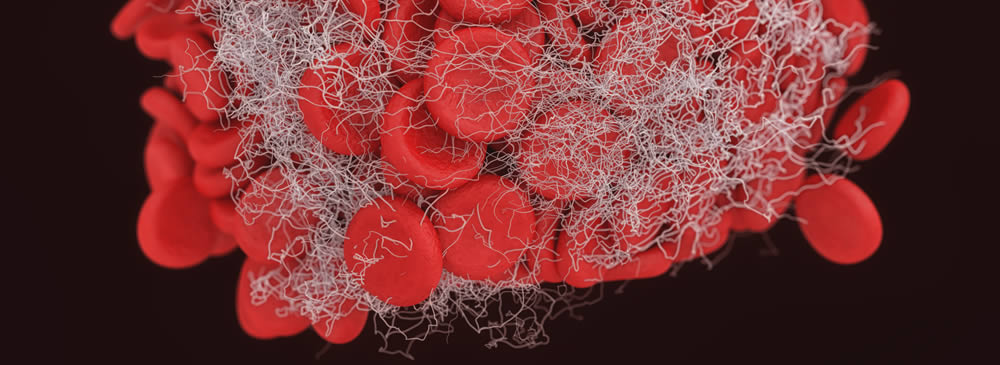
Hematology / Hemostasis
Xenometrix is distributor of 5-Diagnostics in France, a manufacturer of very specialized products in the field of hemostasis and protein purification and manufacturing. The products are also available in other countries, please contact info@xenometrix.ch.
5D-Protein Stabilizer
5D-Protein Stabilizer is used at the place of BSA (Bovine Serum Albumin) in several applications like blocking antibodies/proteins on surfaces, protecting biological activity of enzymes or stability of proteins, supplement in cell culture.
It is a liquid, sterile, highly purified 10% hydrolysed porcine collagen peptide fraction and has no contaminating proteins or agents. Due to the fact, that there is no protein and thus antigenicity, unspecific binding is avoided. 5D-Protein protects biological activity during lyophilisation, freezing, thawing, urea, ethanol or heat treatment.
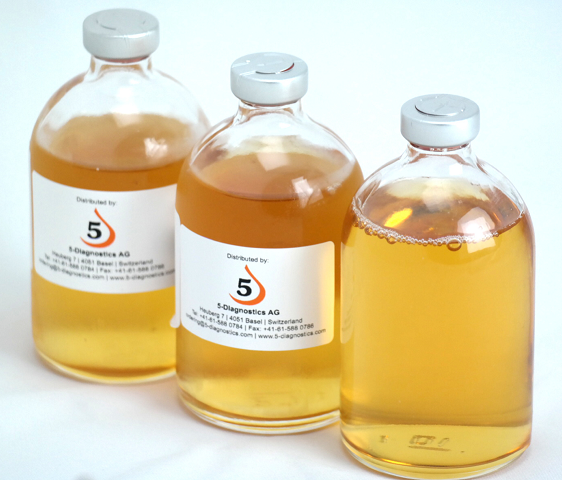
Human Plasmas
Pooled Human Plasmas
Pooled Human Plasma consists of a pool of citrated human plasmas obtained from at least 20 healthy donors and are only allowed for the in vitro use. The plasmas are available in a lyophilized form or liquid frozen and can be used for many different applications, such as diluents for use in the development of IVD assays, as diluents of proteins, other plasmas, spiking experiments, controls in coagulation tests, as well as for other laboratory tests.
In addition to the use of plasma for IVD purposes, plasma is also used in field of ADME Tox to analyse degradation or modification of a drug compound by enzymes in plasma. Studies for plasma stability are usually carried out in the early discovery process to identify potential protein binding or degradation effect. The test compound is incubated in plasma for a time period and aliquots are analysed at distinct time points by LC/MS. The sample taken at time zero is compared to the samples taken at other times.
The binding of test compounds to plasma proteins is an important factor: If a drug is bound to plasma proteins at a substantial percentage, the amount of drug availability and thus its efficacy is reduced. Therefore, plasma binding studies are essential for drug development and may be an indicator for the following in vivo efficacy studies. Rapid equilibrium dialysis (RED) is usually applied for plasma binding studies. Aliquots of the buffer and the plasma are taken at different times and the concentration of free and bound test compound is determined by LC/MS/MS analysis.
For validation of a new method a set of plasmas from different single donors are also available.
Plasmas Deficient of Coagulation Factors, Inhibitor Plasmas
Plasmas deficient in coagulation factors are prepared from screened normal citrated human plasmas, they are plasmas which are depleted of a specific target protein by affinity immuno-adsorption. All other proteins are left intact.
Deficient plasmas are available for most coagulation factors Factor and coagulation proteins.
Normal human citrated plasma is depleted by affinity immuno-adsorption of a specific protein and an inhibitory antibody against the depleted coagulation factor is added, mimicking patients with an inherited or acquired deficiency in coagulation factors.
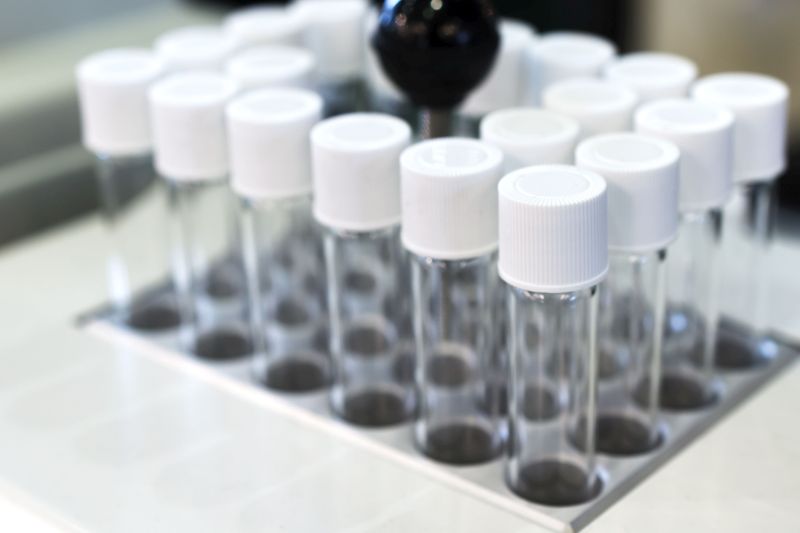
Drug Removal from Plasma - DOAC Remove™, HepaRemove™
DOAC Remove™
It is well documented that drugs like DOACs can interfere in several coagulation assays, especially clotting test like lupus anticoagulants tests, APTT, PT, TT, single factor assays, APC-Resistance and other clotting tests. Removal of these interfering drugs can be easily achieved with DOAC-Remove™.
DOAC-Remove™ tablets eliminate the interfering effect of Dabigatran, Argatroban, Rivaroxaban, Apixaban or Edoxaban in human citrated plasma samples. DOAC-Remove™ has no significant effect on coagulation factors itself.
It is unknown if other drugs (small molecules) are removed as well.
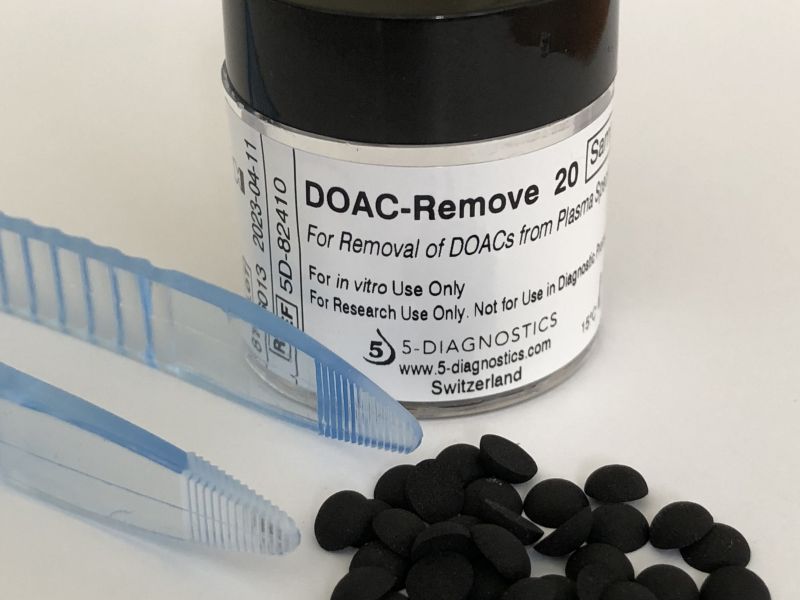
References:
- Does in-vitro addition of activated charcoal allow lupus anticoagulant testing with dRVVT in plasma of patients treated with DOAC?: the CAVIAR study. Jessica Valaize, Demagny Julien, Adrien Borgel, Fabienne Nedelec-Gac, Alain Stépanian, Isabelle Gouin-Thibault, Virginie Siguret. ECTH 2018, P215.3)
- Use of DOAC Stop for elimination of anticoagulants in the thrombin generation assay. Wil F. Kopatz, Herm Jan M. Brinkman, Joost C.M. Meijersa. Thromb. Res. (170 (2018) 97-101.
HepaRemove™
HEPA-Remove™, 1 mg, Lyophilized Powder is a synthetic peptide designed to inhibit heparin and heparinlike activity.
Given its molecular properties heparin and heparinlike molecules are known to interfere with many clinical assays including PCR-based assays and coagulation assays. HEPA-Remove™ is able to selectively complex heparins and thereby inhibit its associated assay interference. HEPA-Remove™ has been used to successfully pre-treat human plasma samples in which coagulation testing would otherwise be impossible.
HEPA-Remove™ has been found to inhibit FXII activation in aPTT based assays. If full FXII activation is required for the correct interpretation of the results, HEPA-Remove™ can be added to the assay after the FXII activation, for example in combination with the CaCl2 reagent in clotting assays.
Polyclonal Antibodies for Blood Coagulation and Fibrinolysis related Proteins
Polyclonal antibodies come in various formats; whole or purified IgG, Affinity Purified IgG, Horseradish Peroxidase conjugated, Fluorescein Isothiocyanate (FITC) conjugated and Biotin conjugated.
Thrombin Generation
In some cases, techniques to detect hypo-coagulable or hyper-coagulable states are not sensitive enough. The thrombin generation assay has been shown to be very sensitive and provide more information in some specific conditions. This technique involves the overall balance between procoagulant and anticoagulant forces and has provided new insights in the coagulation cascade. Several methods are available in the market such as thrombogram method or visualitsation of spatial propagation of the thrombus formation in the blood vessel or fibrin formation.
The thrombin generation test has great clinical potential for the monitoring of risk patients post surgery, risk pregnancy, hypercoagulable conditions due to genetic or acquired thrombotic disorders, bleeding risk.
Thrombin generation assay can also be used to quality control very sensitively implants or extracorporeal devices in direct contact with blood coagulation like valves, stents etc.
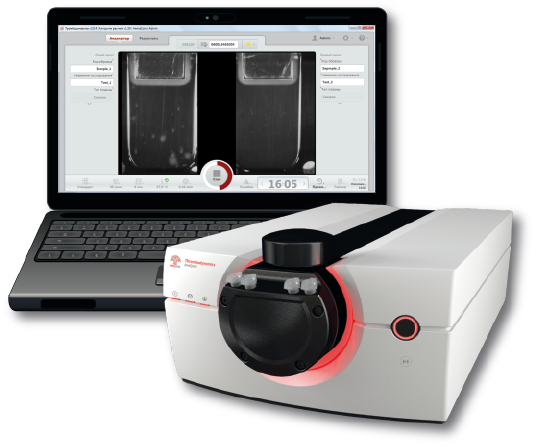

 Navigation
Navigation